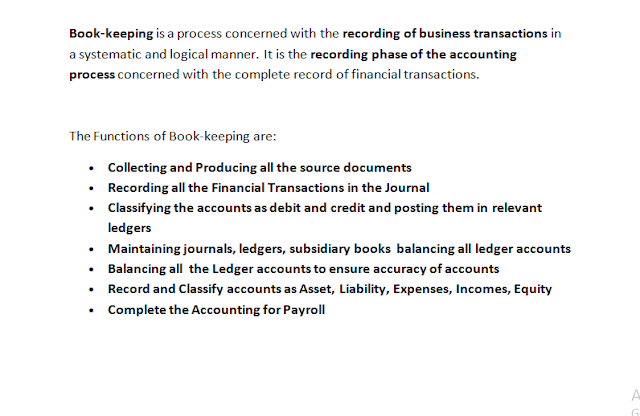Let us conclude as to what are the Functions of Bookkeeping? Are you curious to know the top 7 functions of bookkeeping? Then we have in detail described below.
It involves Collecting and Producing all the source documents, Recording all the Financial Transactions in the Journal, Classifying the accounts as debit and credit and posting them in relevant ledgers, Maintaining journals, ledgers, subsidiary books, Balancing all the Ledger accounts to ensure accuracy of accounts, Record and Classify accounts as Asset, Liability, Expenses, Incomes, Equity and Complete the Accounting for Payroll
Often we use Book-keeping and Accounting as synonyms. We think they are one and the same. But Book-keeping is not the same as Accounting. Instead, Bookkeeping is different from Accounting. Book-keeping is the recording phase of the accounting system while Accounting is the broad term, concerned with summarising phase of the accounting system.
What is Book-keeping?
Bookkeeping is a process concerned with the recording of business transactions in a systematic and logical manner. It is the recording phase of the accounting process concerned with the complete record of financial transactions. Financial statements such as profit and loss a/c and balance sheet do not form part of the book-keeping to ascertain financial performance and position. Accounting helps in the preparation of the financial statements and ascertaining financial performance & financial position.
Objectives of Book-Keeping:
The main objective of Book-keeping is the complete, accurate, permanent record of financial transactions in a systematic and logical manner. The secondary objective is to ascertain the financial effect of recorded transactions on the financial statements such as profit&loss statements and balance sheet.
They are generally two methods of book-keeping system. Two methods are the double-entry system and the single entry system. Mostly, companies and business entities use the double-entry system to record business transactions as it is a complete, reliable, scientific system.
What are the Functions of Bookkeeping?
Let us discuss, as to, what are the Functions of Book-keeping? It is concerned mainly with the record of financial transactions in the journal, and posting them to ledger accounts along with payroll accounting as well.
They may be listed below as follows:
Collecting and Producing all the source documents:
The main function is to record the transactions. To record them, source documents are required as evidence of the recorded transaction. Source documents could be purchase bills, sales memo, vouchers. These documents are required to record the transactions in books of accounts.
Recording all the Financial Transactions in the Journal:
Bookkeepers main function is to record the financial transactions in the books of accounts such as journal, subsidiary books, ledgers for future reference purposes and to facilitate the preparation of financial statements such as profit and loss statement, balance sheet and cash flow statement. Generally, the recording phase involves passing journal entries in a journal based on the source documents.
Classifying the accounts as debit and credit and posting them in relevant ledgers:
The next step after passing journal entries in the journal is to classify the accounts as debit and credit accounts. These accounts are recorded in relevant ledger accounts such as cash a/c, purchase a/c, sales a/c, debtors a/c, creditors a/c. This process of transferring journal entries from journal to ledger is called ledger posting.
Maintaining journals, ledgers, subsidiary books:
Book-Keepers are entrusted with the responsibility of maintaining all the books of accounts in a systematic manner. These include journal, ledgers, subsidiary books, other source documents as a piece of evidence to the recorded transactions as well.
Balancing all the Ledger accounts to ensure accuracy of accounts:
After posting all the accounts into the ledger is to balance the ledger accounts. All the ledger accounts are balanced to know their debit or credit balance. These balanced accounts facilitate the preparation of trial balance, profit and loss statement, balance sheet, and cash flow statement.
Record and Classify accounts as Asset, Liability, Expenses, Incomes, Equity:
All the recorded transactions in the ledger are classified as Assets, Liabilities, Expenses, Incomes, Equity capital. These accounts classification is helpful in preparing a trial balance and financial statements and preparing a chart of accounts i.e, a list of accounts.
Complete the Accounting for Payroll:
Book-Keepers are also given the responsibility of payroll accounting. This is the record of salary details of employees which involves the record of wages, bonus, basic salary, remuneration, incentives to employees. Thus bookkeepers also complete the task of payroll accounting.
Conclusion:
Thus let us conclude as to what are the Functions of Bookkeeping? It involves Collecting and Producing all the source documents, Recording all the Financial Transactions in the Journal, Classifying the accounts as debit and credit and posting them in relevant ledgers, Maintaining journals, ledgers, subsidiary books, Balancing all the Ledger accounts to ensure accuracy of accounts, Record and Classify accounts as Asset, Liability, Expenses, Incomes, Equity and Complete the Accounting for Payroll
Related blogs:
What is Journal? Its features, types, Objectives and uses
What are Financial Statements? Its features, types, uses
What is Income Statement (Profit and loss a/c)?
What is Balance Sheet (Position Statement)?
What are Subsidiary Books? Its features, types, objectives, uses
What is Single Entry System? Its features, types, objectives, uses
What is Double Entry System? Its features, objectives, uses



Thank you for the information about bookkeeping services!
ReplyDeleteAccounting and bookkeeping services has become streamlined globally with the implementation of International Financial Reporting Standards that makes it more technical and complicated.
-Accounting Services in Dubai
Great explanation! Bookkeeping is a crucial part of any business’s financial health, ensuring that all transactions are accurately recorded and organized. From tracking expenses and managing payroll to reconciling bank statements, these functions lay the groundwork for financial reporting and compliance. For companies looking to stay audit-ready and financially transparent, outsourcing to professional accounting services in Dubai can be a smart move. This article is a helpful guide for business owners to understand the importance of solid bookkeeping practices.
ReplyDeletePost a Comment
if you have queries let me know and mail me at syednissaruddin99@gmail.com